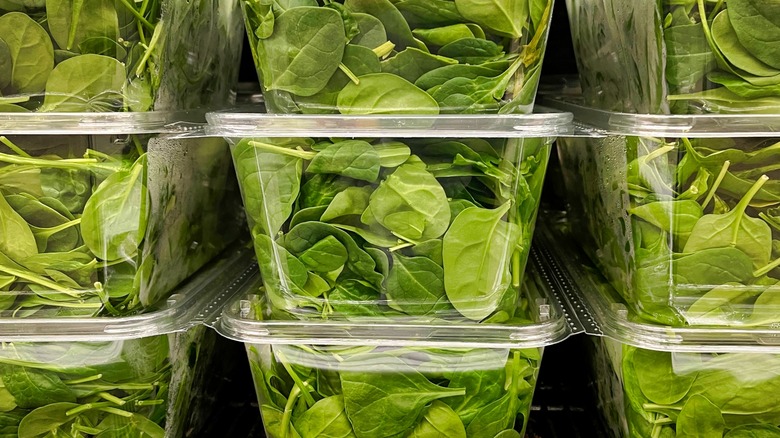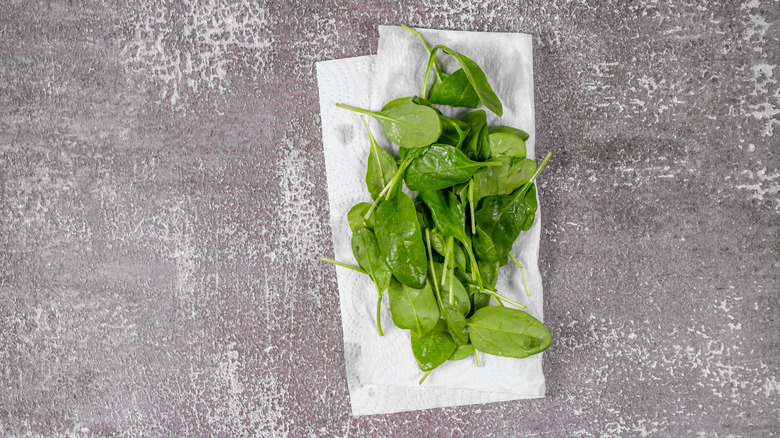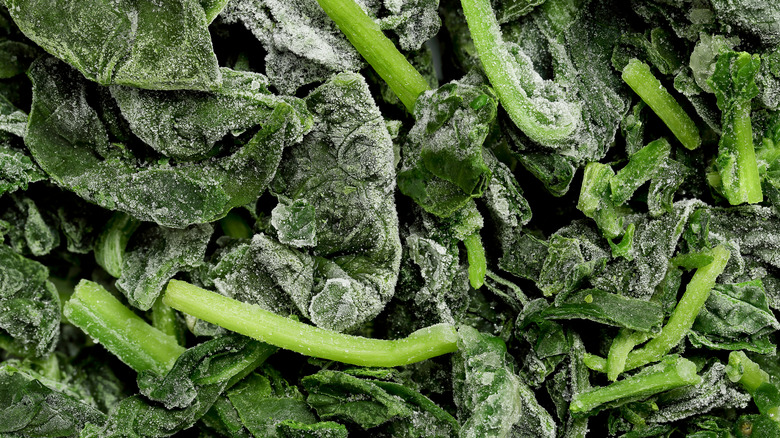The Unique Way To Store Spinach For Added Freshness
Spinach is one of the most popular vegetables in the United States, especially in the category of leafy greens. It's one of the most nutrient-dense vegetables out there, and its reputation as an easy and versatile way to get your greens causes it to fly off the shelves. Despite its popularity, though, many cooks still don't know how to properly store this veggie and avoid the dreaded soggy, mushy, and limp qualities of spinach gone bad.
Unfortunately, spinach is one of the quickest vegetables to spoil, as you probably know if you've ever let it sit in the fridge for a couple days. One of the main reasons it spoils quickly is because many grocery stores sell spinach in plastic bags or boxes, such as in bagged salad mixes. These plastic containers trap moisture, which causes spinach (and other leafy greens!) to spoil.
This is why, when you bring spinach home from the store, you should immediately move it out of its plastic container and into a paper towel-lined container in your fridge, so that some of its moisture can be wicked away as it sits. Don't wash it in advance, either; only right before you plan to eat it. This storage method is both simple and effective, and can help the spinach last three to seven days. To make sure your spinach winds up on the longer-lasting end of that time frame, there are other practices that can cut down on excess moisture, as well.
How to get rid of the moisture in your spinach
Spinach that has been sitting in the grocery store for a few days may have already started to wilt by the time you pick it up. The veggie often travels a long way to get to the store, and can get bruised in transit. Pre-washed spinach may also retain some of the moisture from the washing process, making it go bad faster than unwashed spinach. And since many grocery stores mist their vegetables, even unpackaged spinach can be exposed to a lot of moisture.
If possible, buy fresh spinach tied together in bunches, rather than stored in plastic containers. If plastic-packed greens are all you can find, check the bottom of the bag or box before buying to make sure it isn't wet. When you open the greens at home, pat any excess moisture dry with a paper toweland store it in a container lined with more paper towels. Even spinach that isn't sold in plastic should be stored this way, as condensation is the enemy of leafy greens, and a simple paper towel lining can really help to soak up excess water.
If you want to reduce plastic waste, wipe down the bottom of the container your spinach was packed in, then line it with paper towels and add the spinach back in. And if your spinach still winds up a little wilted, but not slimy, you can revive it with a quick soak in ice water before cooking.
Freeze spinach for long-lasting freshness
If you are planning on waiting more than a few days to use your spinach, you might consider freezing it instead. All you need to do is blanch your spinach in boiling water for about thirty seconds, then plunge it into an ice bath. Strain out the liquid, and freeze it in an airtight container for up to half a year. You could also simply buy frozen spinach, which tends to be far more affordable than fresh. It's a great option if you don't use spinach frequently, but want to keep some around.
Because spinach wilts when cooked, there isn't much of a texture difference between frozen spinach and fresh, cooked spinach. (Compare this to frozen broccoli or Brussels sprouts, for example, which can take on a mushy texture and sulfur-like smell.) It may have a slight metallic taste to it when eaten alone, but frozen spinach can be seamlessly integrated into pasta, rice, or other grain dishes, or blended into sauces or soups, without anyone knowing you didn't use the fresh stuff. If you do prefer fresh spinach, just use the paper towel method and try to eat it all as quickly as you can, and you're not likely to waste any money.



